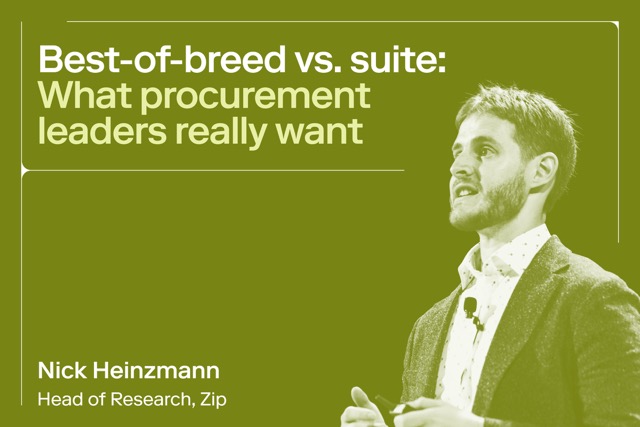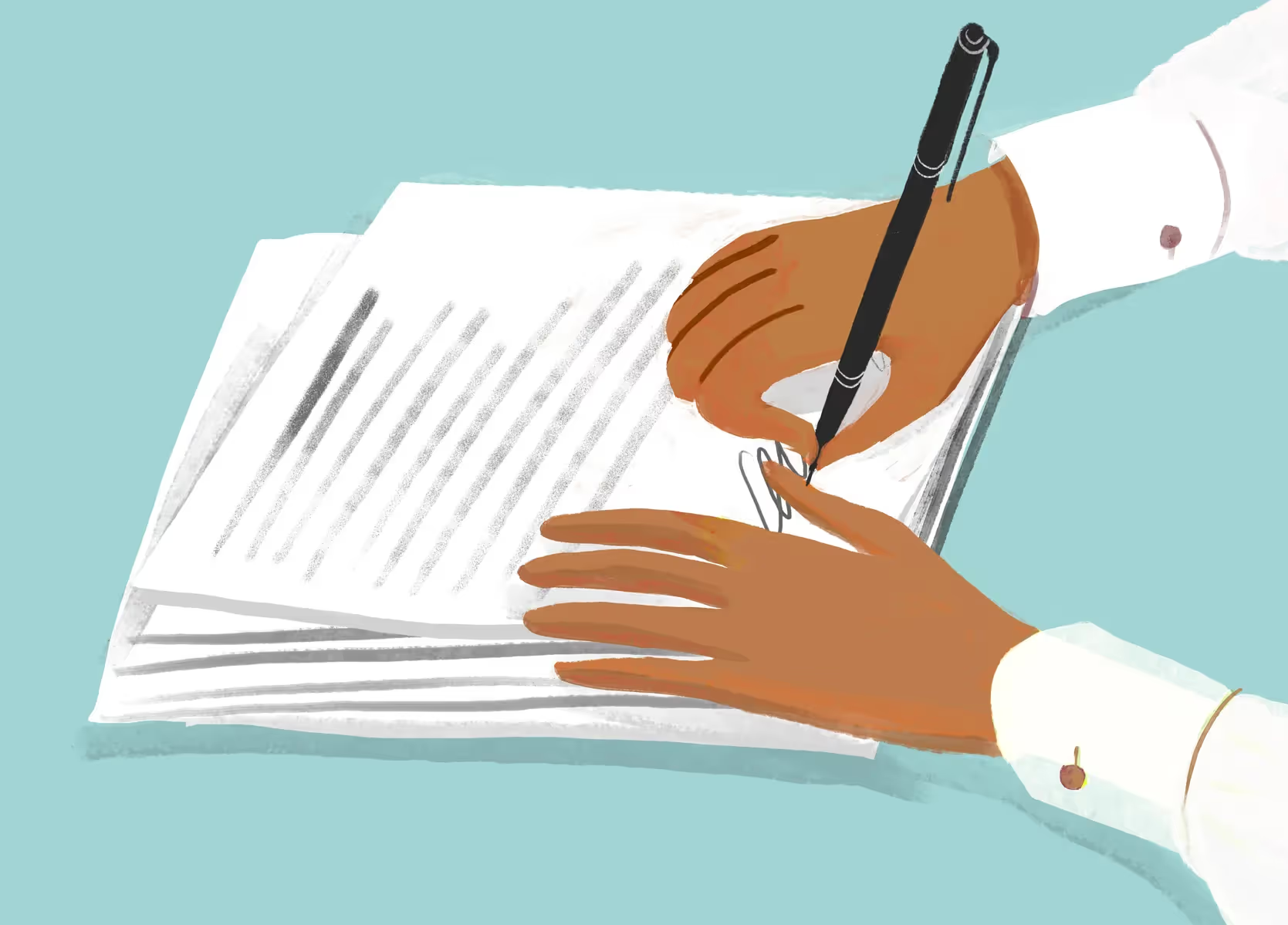
What is spend orchestration? Benefits & how to get started
Why procurement teams are embracing spend orchestration for maximized ROI.

“I just want to buy what I need to do my job.”
If you’ve worked in procurement, chances are you’ve heard this refrain before. From marketing teams looking for a new SaaS tool, or facilities trying to restock their essentials, everyone needs the stuff they need to work. And while these requests are reasonable, the problem is what happens after the ask: a chaotic game of email ping-pong, unclear approvers, compliance gaps, a sea of shadow spend. That is both inefficient and expensive.
That’s where spend orchestration comes in.
At its core, spend orchestration is about making business flow. It connects every step of the procurement journey—from the moment an employee has a need to when the supplier gets paid—so that nothing gets lost, stuck, or duplicated. It’s the evolution of traditional spend management, built for the complexity of modern, distributed teams.
In this article, we’ll break down what spend orchestration actually means, why it’s different from legacy spend management, and how your organization can benefit from this modern approach.
We’ll also show you how to get started: because the future of procurement isn’t coming someday. It’s already here.
What is spend orchestration?
Spend orchestration is the strategic coordination of all procurement activities, systems, and stakeholders involved in how a company spends money. It ensures that every purchase, from initial request to final payment, is seamlessly routed, reviewed, and recorded in a way that aligns with company goals, budgets, and policies.
Whereas spend management was about tracking spend, spend orchestration is about activating it. It connects intake management, approvals, sourcing, contracting, purchasing, and payments into a unified, intelligent process.
Let’s break down the core components:
- Spend analysis: Surfaces patterns in purchasing behavior to identify savings opportunities and spot risks.
- E-procurement: Digitally handles purchasing processes, from requisitions to purchase orders.
- Contract management: Centralizes contracts and ensures purchases align with terms.
- Supplier relationship management (SRM): Builds and maintains productive partnerships with vendors.
- P2P solutions (Procure-to-Pay): Automates the transaction process, often powered by AI to recommend suppliers, flag risks, and accelerate approvals.
Real-world example? Northwestern Mutual used Zip spend orchestration to align workflows, provide visibility across global procurement, and have collaborative conversations and stakeholder alignment across the procurement process, saving significant resources in both dollars saved—and time managed.
“We estimate we’ve saved up to 18% over the last year, and increased our spend under management by as much as 20%,” said Christopher Kee, Vice President of Sourcing and Procurement. “Senior leaders can finally have procurement conversations with a strong level of confidence,” Kee said, all due to the power of spend orchestration.
Spend orchestration vs. spend management
To understand the shift, it helps to look at the legacy model.
Spend management is a familiar concept. It refers to the processes companies use to monitor, control, and report on their spending. The emphasis is on visibility: who’s buying what, from whom, and how much it’s costing. Tools in this space help track expenses, enforce budgets, and catch irregularities. (Read more in our Spend Management Guide).
But here’s the problem: spend management is reactive.
It focuses on what’s already been spent. And in today’s business world, where spend is distributed across departments, locations, and tools, visibility alone isn’t enough. That’s like trying to drive using only your rearview mirror.
Spend orchestration, on the other hand, is proactive and dynamic.
It doesn’t just look at spend after the fact. It weaves together the full procurement lifecycle, starting with employee intent (via intake) and guiding the process forward. It ensures everyone—requesters, approvers, buyers, vendors—is working off the same playbook, in real time.
Think of it like this:
- Spend management is bookkeeping.
- Spend orchestration is conducting a symphony.
One tracks the notes. The other makes the music.
Benefits of spend orchestration
The right spend orchestration strategy can transform the way your entire business runs. Let’s walk through the key benefits of orchestration.
Reduced costs
Spend orchestration helps you cut costs in ways that traditional oversight never could:
- Centralized sourcing and better visibility into vendor pricing allow smarter negotiations.
- Maverick spend gets eliminated by routing requests through compliant, approved channels.
- Automated workflows reduce manual processing, slashing administrative costs.
- Improved payment terms and early payment discounts optimize working capital.
For more strategies, check out our cost reduction tips in procurement.
Increased ROI
Procurement is no longer merely a back-office function: it’s a strategic lever. Spend orchestration ensures you get more from every dollar spent:
- Streamlined procurement processes reduce overhead and improve efficiency.
- Stronger contract management helps extract maximum value from supplier agreements and mitigate risk, especially guided by AI-powered contract review experience.
Increased efficiency and productivity
Speed matters—and spend orchestration delivers:
- Automated intake and approval processes slash cycle times.
- Central platforms foster better collaboration across procurement, finance, and business stakeholders.
- Manual tasks are replaced by automation, freeing up teams for high-impact work.
- Self-service procurement empowers employees to act quickly within guardrails.
Improved compliance
Compliance is a cornerstone of effective procurement, and spend orchestration can help here too.
- Automated rules and workflows enforce internal policies and external regulations.
- Clear audit trails reduce the risk of fraud and SOX violations—a key component to responsible scale.
Better supplier management
Suppliers are the fuel of the engine of procurement, and maintaining relationships is a must. Spend orchestration helps strengthen those relationships:
- Real-time visibility into supplier performance enables smarter decisions.
- Automated onboarding and communications make working with you easier.
Smarter decision-making
With orchestration, data becomes a strategic asset that powers the entire process:
- Real-time analytics provide insight into spend patterns, bottlenecks, and opportunities.
- Better forecasting and budgeting accuracy support smarter planning.
Increased agility
Markets move fast. So should your procurement.
- Flexible workflows adapt to changing business needs.
- Risk mitigation becomes part of the process, not an afterthought.
Spend orchestration is the connective tissue between business needs and procurement strategy. It aligns stakeholders, eliminates friction, and drives impact. It’s not just for procurement leaders—it’s for finance, IT, and business users who want to move smarter, faster, and with more confidence.
How to implement spend orchestration for better spend visibility
Implementing spend orchestration doesn’t require a massive overhaul, but it does require intention. The key is to start with a clear picture of where you are today, what you want to improve, and how technology can help you get there.
Here’s a step-by-step guide to building a strong foundation.
1. Assess your current state
Before you can improve your procurement process, you need to understand it. That starts with conducting a thorough spend analysis to identify where your money is going, who’s spending it, and how it's being tracked (or not tracked).
Next, map your existing procurement workflows. How do intake requests flow today? Where are the bottlenecks? Which tools are used, and which are bypassed? This process mapping should include finance, IT, legal, and any other function involved in spend approvals or supplier onboarding.
Finally, evaluate your current tech stack. Is it fragmented? Are there duplicate tools across departments? Understanding your baseline gives you the clarity needed to move forward with confidence.
2. Define your objectives and scope
Spend orchestration doesn’t have to solve everything at once. In fact, the best implementations start with clearly defined goals and a focused scope.
Are you trying to reduce rogue spend? Speed up cycle times? Improve compliance? Get executive alignment by identifying the top 2–3 outcomes you’re looking to drive.
Then define your implementation scope: which teams, business units, or categories will be included in the first phase? Bring in key stakeholders from each function, from procurement, finance, IT, legal, and department leaders early in the process. Their buy-in will be vital not only to implementation, but long-term adoption.
3. Select and implement the right tools
Not all platforms are built for orchestration. Many legacy tools were designed for centralized purchasing teams—not distributed, fast-moving orgs. When selecting a spend orchestration solution, look for:
- Unified intake management that captures employee needs at the source
- No-code workflows to adapt to your business processes without developer lift
- Real-time spend visibility that’s accessible to procurement, finance, and business leaders
- AI-powered guidance to accelerate approvals, identify the right suppliers, and flag risks
- Seamless integrations with your ERP, P2P, CLM, and budgeting tools
This is where Zip stands out. Zip’s procurement orchestration platform was built from the ground up to address the full procurement lifecycle. It starts with a smart, guided intake experience that routes each request to the right stakeholder automatically. Zip integrates with the tools you already use, provides savings tracking, and delivers real-time visibility into spend across your organization.
Whether you’re a growing commercial business or a global enterprise, Zip helps you stay agile without sacrificing control.
4. Design and optimize processes
Think of implementing spend orchestration as an opportunity to rethink how your procurement processes work.
With the right orchestration platform, you can eliminate redundant steps, introduce automation where it matters, and implement policy-based controls that flex to the needs of each purchase. Want to auto-approve low-risk purchases under $1,000? Done. Need legal review for SaaS tools over $50K? Easy to configure.
This flexibility empowers teams to collaborate more effectively and take action faster—without getting buried in manual reviews or endless email chains.
5. Train and engage your team
Change management can make or break an orchestration rollout.
Even the best-designed workflows won’t deliver value unless people actually use them. That’s why it’s important to prioritize training, not just on the tool, but on the why behind the change. Make it clear how spend orchestration will help teams move faster, stay compliant, and reduce busywork.
Encourage feedback from users, and treat adoption as a continuous journey. The best orchestration strategies evolve based on how the business grows. Regularly check in, gather insights, and refine workflows over time.
6. Track your success
Once you’re live, it’s time to measure what’s working, and what’s not.
Identify and track key KPIs such as:
- Request-to-approval cycle time
- Rate of maverick spend
- Percentage of compliant purchases
- Number of suppliers onboarded
- Overall cost savings
Use real-time dashboards and analytics to identify trends and opportunities for improvement. The more visibility you create, the more impact your team can have.
The future of spend orchestration
The next generation of procurement will be driven by intelligence, automation, and adaptability.
Technologies like AI and machine learning will accelerate sourcing, flag risks, and even recommend the optimal purchase path. And as tools become more interconnected, the procurement experience will become more intuitive—more like consumer commerce, but with enterprise-level controls.
Spend orchestration is the foundation for that future. It enables you to plug into innovation as it evolves, without having to rebuild your processes every time something new comes along.
Check out these 25 Procurement Predictions to see where the industry is headed next.
Don’t just manage spend—Orchestrate it
Spend orchestration is a fundamental shift in how businesses handle procurement. It replaces outdated, siloed systems with a unified, intelligent approach that adapts to the way modern teams work.
By orchestrating spend instead of just managing it, you unlock faster decision-making, stronger compliance, and greater control across every dollar your company spends. And the best part? It’s more intuitive for employees, too.
Ready to make spend orchestration real at your company?
Zip’s procurement orchestration platform helps companies of all sizes streamline intake, automate workflows, and unlock real-time spend visibility. With features like AI-guided routing, savings tracking, and centralized approvals, Zip gives you the tools to move faster—with confidence.
Curious how it would work in your org? Request a demo and see what orchestration could look like for you.

Maximize the ROI of your business spend

Enter your business email to keep reading


























.webp)




















.avif)













.avif)










.webp)





.avif)












.avif)
